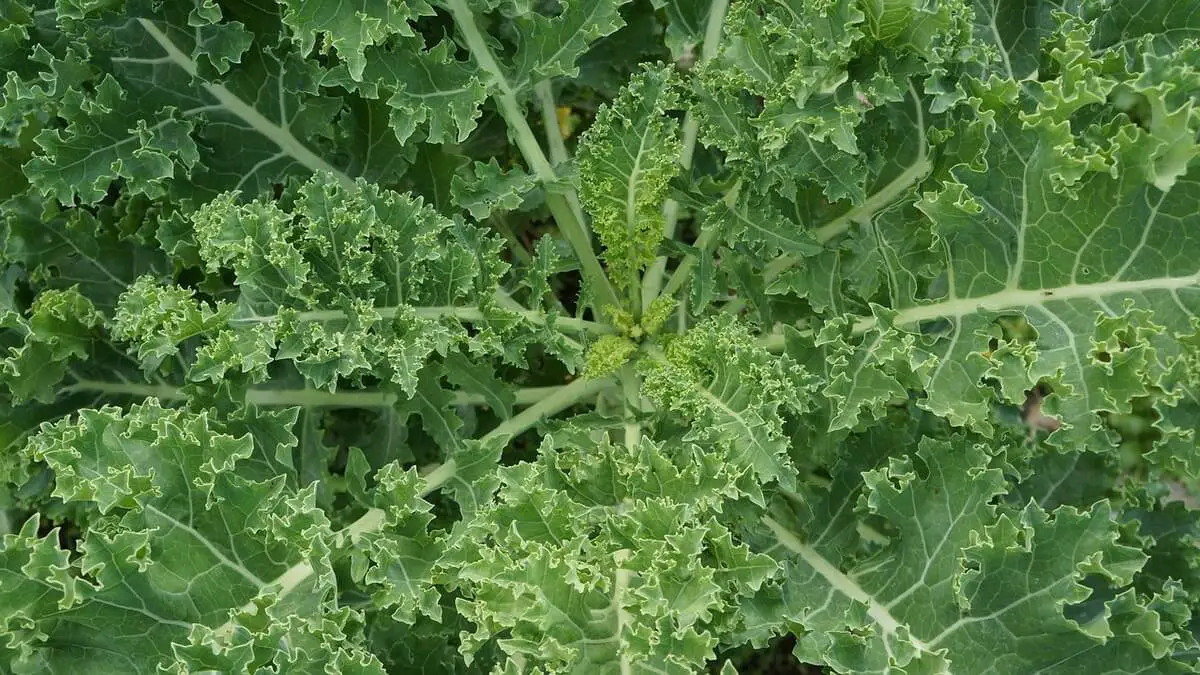How to Grow Perennial Kale in Garden
Perennial kale is an easy to grow, hardy, tasty, productive, cruciferous vegetable. The common species (Brassica oleracea) includes various food cultivars including cauliflower, broccoli, cabbage, and kale.
This article focuses on perennial kale, its characteristics, and its popular varieties.
In general, the Brassica oleracea species plants are Indigenous to western and coastal southern Europe. In their uncultivated form, its existence dates back to several millenniums.
However, studies indicate the existence of cultivated varieties dates back to the Greek and Roman eras.
Table of Contents
Characteristics of Perennial Kale
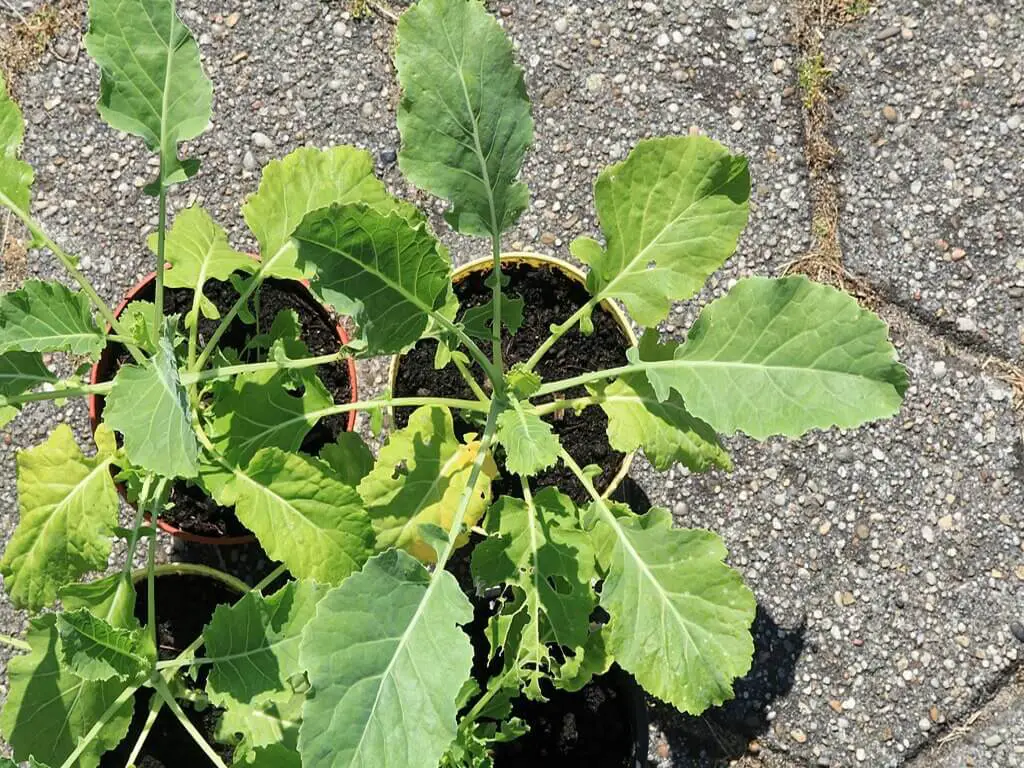
Photo by GFDL (Wikimedia Commons) (CC BY-SA 3.0)
These plants can grow well in different types of soils and climates. They can tolerate seasonal shades too to some extent. Generally, these plants are hardy to USDA Zones 6 – 9. (almost equivalent to UK zone 7)
The perennial kale varieties are best known for their low maintenance requirements. Being Perennials, they can live up to 5-6 years.
Generally, these perennial kale varieties are more delicious to consume than standard annual or biennial varieties. They are also less bitter than their counterparts and have a mild, nutty taste. The leaves are about the same size as common spinach.
These evergreen plants start growing during the spring. However, they serve as winter vegetables too, when other consumable vegetations are scarce.
This variety of plants form clumps at the base and spread quicker. However, they are not vigorous growers or invasive plants.
Most kale varieties have similar propagation methods. So, they are easy to propagate too. Our article explains these processes in detail.
Nutrition Facts
In general, Kale contains two powerful antioxidants, flavonoids, and carontenoids. These two elements are essential to fight and protect our cells from free radicals. They also prevent the formation of cancerous cells to some extent.
In addition, every cup of kale (about 67 grams) contains 684% (RDA) of vitamin K, 206% (RDA) of vitamin A, and 134% (RDA) of vitamin C. Also, fat (0) and calories (36) are just icing on the cake.
Types of Plants
Annuals
These types of plants grow, live, and finally, die in one growing cycle (usually a year). Most gardeners grow kale as annuals.
Biennials
Some plants shoot up during the first growing cycle reproduce and die during the second growing cycle. Most of the kale varieties fall under this category.
Perennials
Plants with less or no woody stem they are called perennials. Technically, plants that live more than a couple of years are called perennials. There are some cultivars of kale that fall under this category. We have listed a few of them below in this article.
Varieties of Perennial Kale
Daubenton Kale (Brassica Oleracea Var Ramosa)
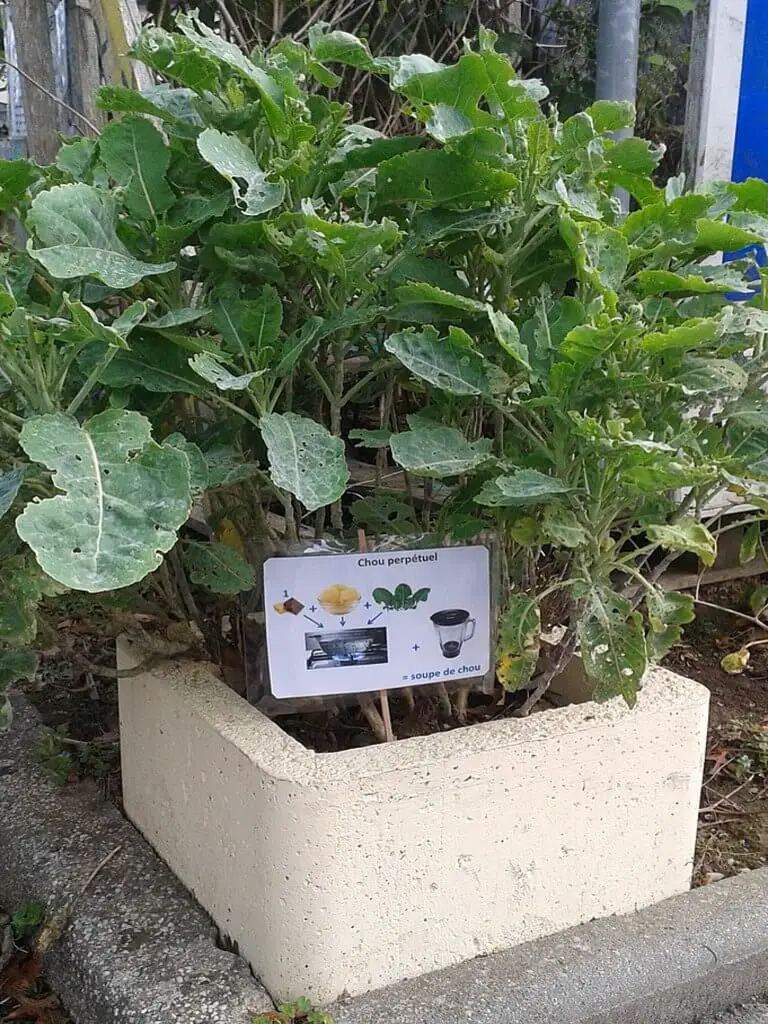
Photo by FarceRéjeane (Wikimedia Commons) (CC BY-SA 4.0)
This perennial kale variety is named after Daubenton, a French naturalist. Most commonly, growers propagate this variety from cuttings. Since this is a cultivated variety, you cannot find them growing wild in forests.
This perennial kale variety can live for 5-6 years. It grows well in USDA Zones 6 – 9. It is hardy to cool temperatures as low as 10-degree Fahrenheit.
In spite of huge demand, it is hard to find a cutting in the market. You can request your friendly gardeners for the same!
Upon propagation, the outer stems tend to grow horizontally. They also root down wherever they touch the ground surface. Thus, Daubenton kales grow by forming clumps. The success ratio may differ.
When the plant nears its death, you can cut through the roots and try replanting. You can repeat the replanting process as many times as you wish. They will grow fresher and healthier almost every time.
Due to the long history of propagation through cuttings, these plants have almost lost their ability to flower. Hence, you can find them blooming rarely. This adds to the scarcity of Daubenton kale seeds in the market.
However, there are a few variegated hybrids (of Daubenton kale), available in the market. These variegated hybrids exhibit similar growth habits and tastes (upon consumption) to Daubenton kale.
Naturally, Daubenton kale is less prone to many pests and diseases. However, these plants are less immune. Hence, it is advisable to amend the soil with organic content occasionally.
You can use pesticides and Insecticidal soaps to treat most of the pests and diseases. Cover the plants with wire mesh to protect them from pigeons and Sparrows.
Jersey Cabbage (Brassica Oleracea Longata)

Photo by Sherwin Carlquist (Wikimedia Commons) (CC BY-SA 3.0)
This perennial kale variety has many names such as walking stick, tree cabbage, Jersey kale, cow cabbage, giant cabbage, and many other local names. The Jersey cabbage (Brassica oleracea longata) is indigenous to the Channel Islands on the English Channel.
You can easily propagate this variety from seeds. You can purchase the seeds online from amazon or any nearby nursery.
Generally, you can grow these plants in USDA Zones 6-9. This variety is hardy to cool temperatures as low as 10-degree Fahrenheit. They prefer to grow in alkaline or neutral soils. The propagation and harvesting methods are almost similar for all kale varieties. You can find more through our article.
The long stalks of Jersey cabbage can reach 6 – 10 feet (1.8 – 3.0 meters) in height. They can also grow up to 20 feet (6.1 meters) or more depending on the growing conditions.
These stalks serve the wood industry in the manufacturing of walking sticks and rafters (wooden beams used in construction). Interestingly, the merchants around the world exported more than 30,000 pieces of such walking sticks during the 20th century.
Generally, the leaves of Jersey cabbage serve as fodder crops for animals. The Portugal growers cultivate a variety of this cabbage, specifically to feed livestock.
As per the Farmer’s Magazine (1836 edition), five plants of this variety can serve about 10 cows or 100 sheep. These sheep (fed by Jersey cabbage) are rumored to produce lengthy (25 inches or 64 cm) silky wools.
However, the real Jersey cabbage at the top is small in size. You can also use the leaves of Jersey cabbage for cooking domestically.
Sea Kale (Crambe Maritima)
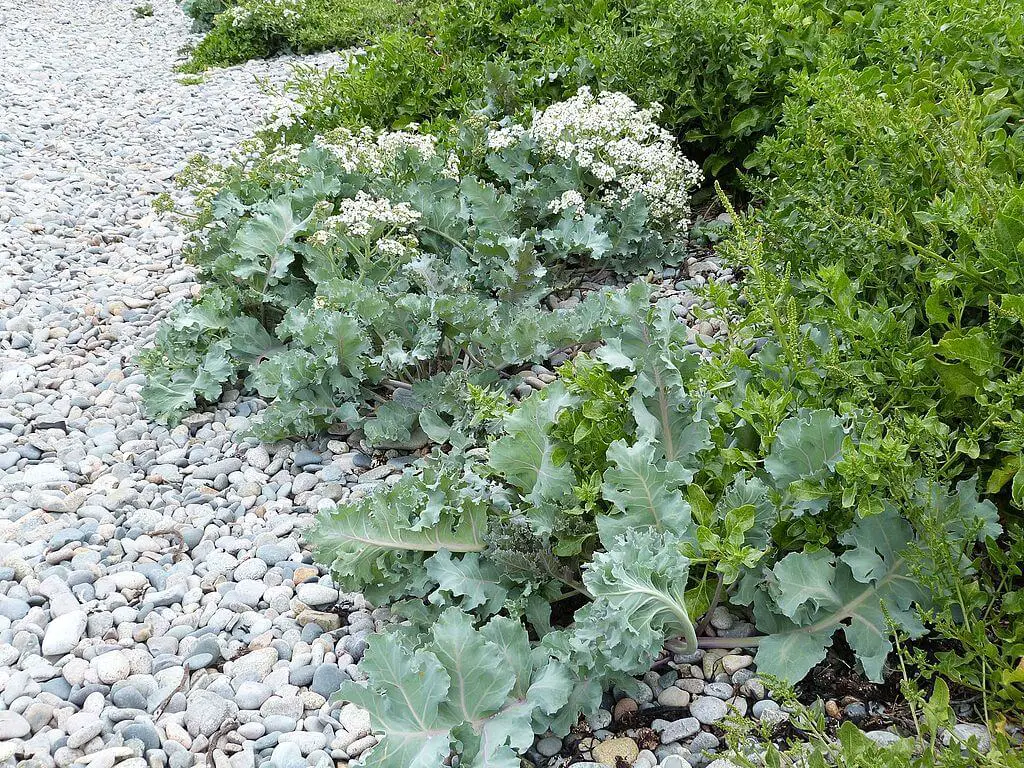
Photo by Thérèse Gaigé (Wikimedia Commons) (CC BY-SA 4.0)
This is one of the most popular varieties of perennial kale. Royal Horticultural Society appreciated this variety as an ornamental plant with its Garden Merit Award.
Generally, sea kale belongs to the Brassicaceae (Cruciferae) family. Technically, it is a species belonging to the Crambe genus.
Sea kale is indigenous to European coasts. You can find them growing wild across the coasts of the black sea to the North Atlantic Ocean.
English farmers cultivated sea kale as a vegetable during the 18th century. The British consumers preferred eating blanched stems of sea kale. However, this perennial kale gained popularity in Victorian times, during the mid-19th century.
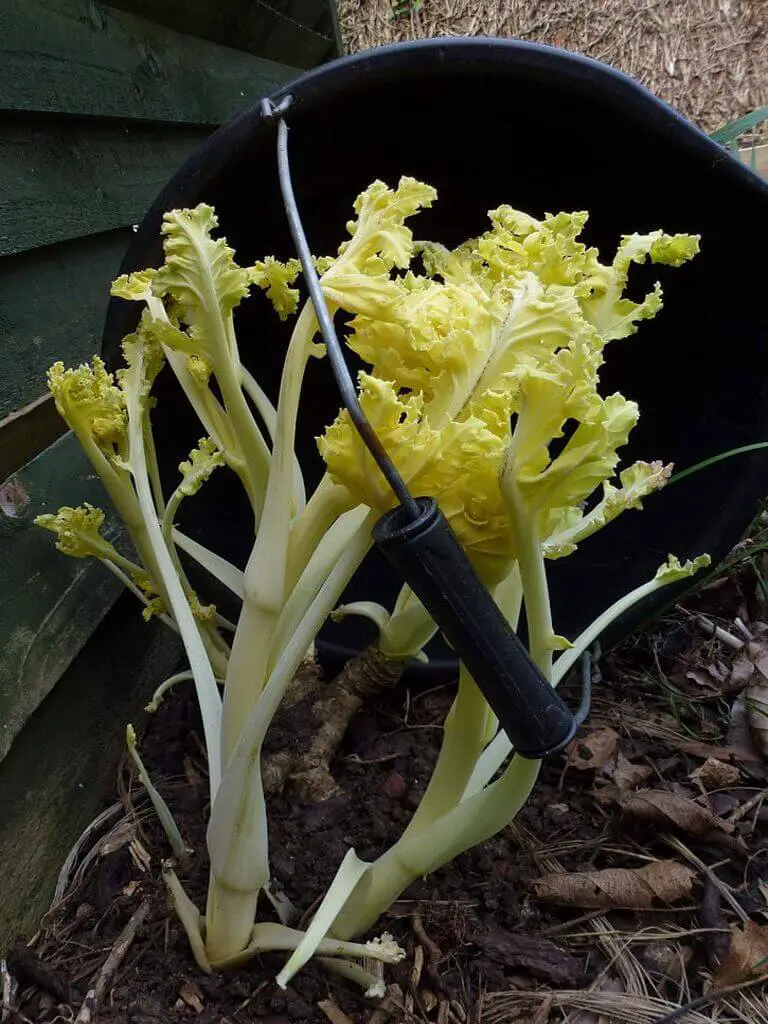
Photo by Stevechelt (Wikimedia Commons) (CC BY-SA 3.0)
In America, you can find sea kales growing along the Pacific Northwest coastal lines. This region has an almost similar climate as Europe.
However, it is easy to grow them in your gardens too. USDA recommends growing them in zones 6 – 9. Purchase the seeds from online stores like amazon or any nursery. Usually, the germination rate of sea kale is low.
This plant prefers to grow in sunny locations with sandy soil. Usually, most varieties of kale have almost similar propagation methods. You can find the propagation details in our article.
Normally, this variety grows 30 inches (75 cm) tall and spreads 24 inches (60 cm) wide. It has fleshy (glaucous collard), large leaves, and white flowers. The seeds develop inside globular pods.
Make sure to amend the soil with compost or manure occasionally. Naturally, these plants are vulnerable to slugs and other pests. Wash the plants with a strong blaze of hose water.
Use a horticultural oil or neem oil to treat the common pests. You can also try organic insecticidal sprays to remove the pests.
Uses of Perennial Kale
Culinary use
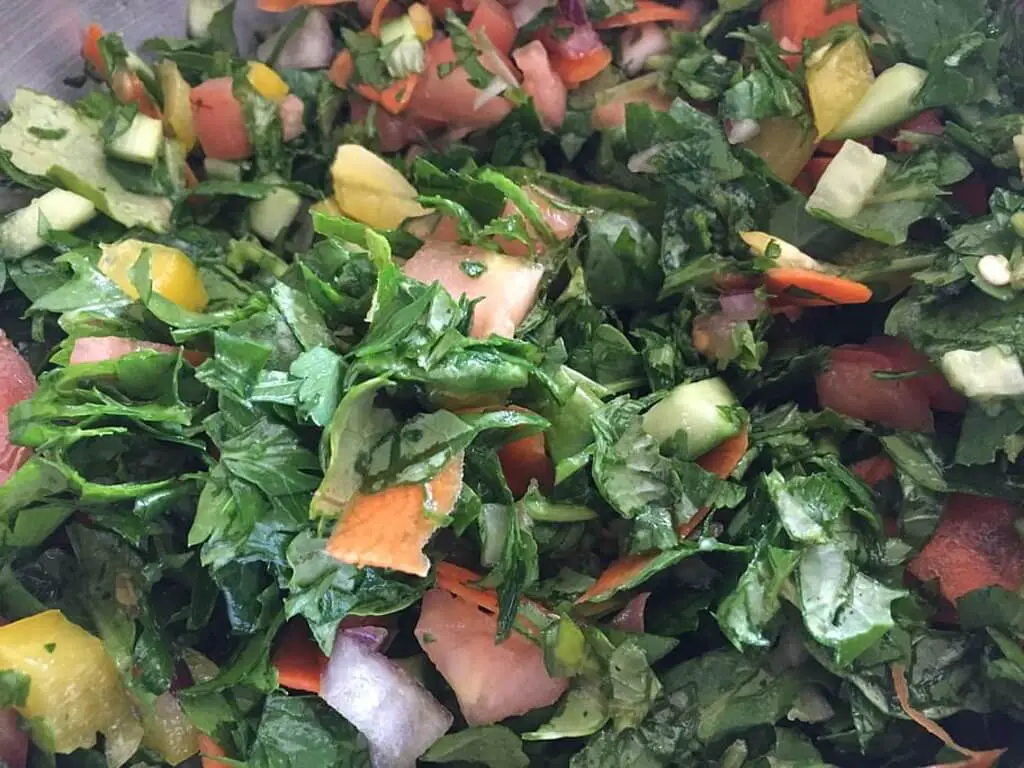
Kales in common, including most varieties of perennial kale, can serve as ingredients in various foods.
Salads
The kale leaves along with avocado and olives as ingredients can serve as one of the nutrient-rich salads in the world.
Soups
You can make delicious mouth-watering soups with kale. These soups are nourishing too!
Tamales Fillings
Kale increases the leafy crisp taste like other green herbs to the tamale fillings. You can fill tacos with these delicious filings.
Breakfast Casserole
Generally, physicians and health experts suggest intaking nutritious breakfast for health-related reasons. The addition of kale provides the most essential nutrients and also enhances the deliciousness of the food.
For example, you can add kale and other vegetables to strata (bread pudding). This enhances both taste and nutrition of strata.
Food Stuffing
You can add kale in various food stuffing including the famous cornbread stuffing. Kale changes the basic taste of stuffing depending on the quality, quantity and variety of kale leaves used.
Grilled Side Dishes
Using a perforated pan, grill the stemmed kale leaves till they turn smoky. Toss them gently with bacon. Apply lemony dressing for adding more value!
Pizza Toppings
You can use kale in pizza toppings. This enhances the flavor and tastes distinct.
You can find detailed cooking instructions in guides. Make sure to keep a food guide handy, as it can be a lifelong asset in your kitchen.
Ornamental use
Some Kale plants including some varieties of perennial kale can decorate your garden space or in-house patios. Royal Horticultural Society supported this argument by appreciating sea kale with its prestigious Garden Merit Award.
Similar Posts
How to Grow Mortgage Lifter Tomatoes
Growing Tomatillos in Gardens

